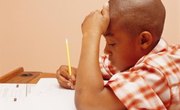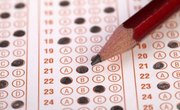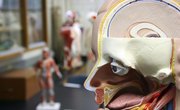The ERB test, as it's commonly known, is a standardized assessment given in New York City and used by schools as part of their admissions process. It's given one-on-one and takes about 60 minutes to complete. Scoring well on this assessment can help students get into the school of their choice. The ERB is divided into two sections, verbal skills and nonverbal skills. Four sub tests are given in each section.
Vocabulary

In the verbal section, children's vocabulary is evaluated by asking them to tell what a word means. For example, the evaluator may ask "What is a knife?" The child will need to know the word and be able to express himself verbally to answer the question. Another subsection assesses the child's ability to process similarities between objects. For example, "Dogs and horses are both?" Students will need to be familiar with both words and identify what they have in common.
Comprehension

Another part of the verbal skills section assesses comprehension and information knowledge. Here children are asked to show what they know and their understanding of various topics. In the comprehension section they may be asked a question like, "What is money used for?" In the information section, for some items they will be asked to choose the correct answer from a set of pictures. For example, "What do dogs drink from?" They will also be asked questions to test general knowledge such as, "Tell me the name of a flower." Again, students must be able to express themselves verbally and know the information the examiner is asking about.
Picture Concepts

Children are also tested on non-verbal abilities. Picture concepts is one sub test in which children are shown various pictures and must use reasoning and categorizing skills to match the pictures that go together. In another non-verbal sub test children complete matrix reasoning. They are shown matrices with a picture in each box and are asked to fill in the missing box by choosing from a bank of pictures. This measures visual skills and reasoning ability.
Block Design and Bug Search

In the block design sub test, children are asked to use two-colored blocks to recreate an image shown by the examiner. This is a measure of visual abilities and the ability to complete a complex task. In the bug search sub test, children are shown an image of a bug and asked to find matching images in a row of other pictures. The speed and accuracy with which they are able to do this is assessed. It is designed to test memory, visual perception and concentration.
Related Articles
References
Writer Bio
Katrice Morris is an educator based in Georgia. She has six years of classroom teaching experience in the primary grades and certified to teach grades Pre-K through 8 in the state of Georgia. She holds an Master of Education in instructional leadership from the University of Illinois at Chicago.











